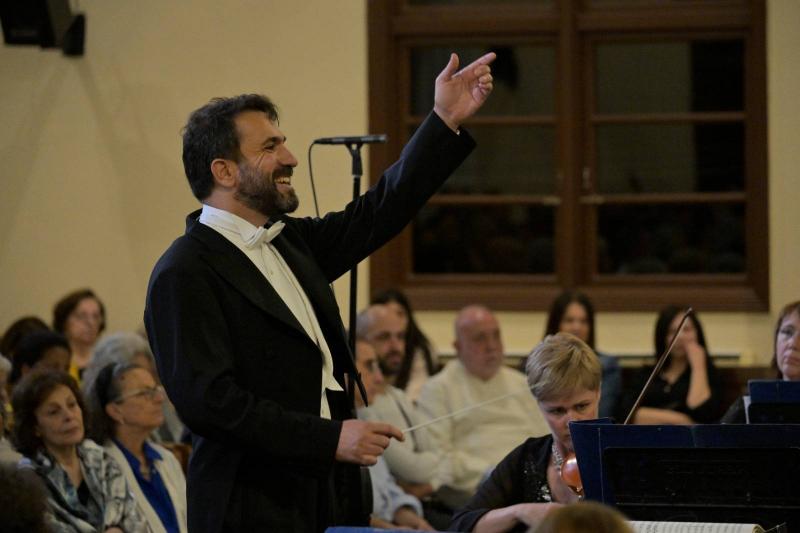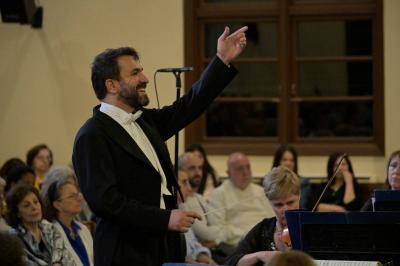At the invitation of the president of the National Higher Institute of Music, composer Hiba Kawas, the Lebanese Philharmonic Orchestra held a concert at the Armenian Evangelical Church in Beirut, conducted by maestro Lebanon Baalbaki, with the participation of British-Jordanian pianist Karim Said, who holds Lebanese citizenship. This event was part of the regular concerts organized by the institute for national orchestras featuring both global and Lebanese conductors.
The celebration was attended by political, diplomatic, cultural, and media figures, as well as a large audience of music lovers and followers of concerts at the National Conservatory. In an atmosphere of elegance characteristic of the Philharmonic Orchestra, the evening opened with Mozart, taking flight with its performance under the maestro's baton, announcing the start of the concert with Piano Concerto No. C major, K. 467 (Allegro maestro, Andante, Allegro vivace assai), known recently as "Elvira Madigan" due to its second movement's significant contribution to the overall ambiance of the film bearing the same name. The work was composed within a month of the vibrant D minor concerto, K. 466, and serves as a brilliant comedic antidote to it. Its serene introduction, reminiscent of a march with unified string tones, sets the stage in a comic opera style, allowing ideas to flow that, while interesting in themselves, successfully convey an atmosphere filled with anticipation.
In this orchestral opening, the winds play important supportive roles: they initiate with small horn calls, actively moving around the strings, or burst onto the stage with bright melodies. The piano remains in the background until the third appearance of the march theme in the orchestra. When it enters, it does so cautiously, following Mozart's intention, offering two shy attempts to attract attention. Then, it gathers more courage, ventures further, and seeks to reach a higher place on the keyboard, which it finds, pauses, and then joyfully lingers over the march theme in the strings, finally taking off completely as Mozart composed it. Before the piano presents the true second theme, there is an evocative passage that anticipates the opening of the grand symphony in G minor, but this seriousness is easily surpassed by the warmth of the second theme, unparalleled in its brightness. The delicate, nocturnal atmosphere of the second movement is carried by the gentle urgency of the instrumental trios throughout. Unusually large melodic leaps impart an internal anxiety to the music that evolves into a tragic sadness in a dark passage pierced by orchestral dissonances and piano calls. This space captivated the audience and transported them to a different world of listening, featuring a dense flow of melody, so that the musical pleasure in this work was uninterrupted from the opening until the last note, seamlessly embodied by pianist Said with the conductor's support and complete harmony between conducting and playing, conspiring to create beauty and manifest the grandeur of music. With his agile and brilliant fingers, he showcased the melodies with clear melodic structure, delivering them to the farthest reaches of pure musical pleasure, in an ethereal space that enchanted the audience with interaction, elegance, and admiration.
In the other section of the program, Dvořák's Eighth Symphony in G Major, Opus 88 (Allegro con brio, Adagio, Allegretto grazioso, Allegro) was dedicated. This symphony displays characteristics of joy, in contrast to Dvořák's gloomy Seventh Symphony, which he composed four years prior. However, if we listen carefully, we may be surprised by the quantity of music in the minor scale that actually occupies this symphony in the major scale, starting from the majestic introduction which is richly orchestrated to highlight the mid-range instruments. Yet, the cheerful expectations are interspersed thanks to the birdsong of the solo flute, evolving into the super-energetic main theme of the movement. Nevertheless, the gloomy music of the introduction returns as the movement progresses, and the development section fills with ominous passages. This balance was intentional. When Dvořák planned the movement, it was unmistakably joyful. The introduction in the minor scale came as an afterthought, as did the more difficult trick of reintroducing reminders of it in the current flow of the piece. Ultimately, this opening movement provides a wonderful example of how the sun seems to shine brighter after being darkened by fleeting shadows.
Similar contrasts characterized the second movement, which even in its opening measures displays significant mood ambiguity: lavish, warm string sequences lead to hints of a gloomy march (still in the strings). After a third of the movement, this contemplative mood is interrupted by what seems like a country band playing Wagner. The calm music returns, seemingly guiding this movement to its conclusion when Wagnerian passion erupts once more, now with greater intensity, before this finely crafted musical movement fades to a quiet end. The third movement, with its folk character—perhaps a waltz—is also somewhat melancholic, standing out with its introspective style in the minor scale. The central trio section presents some of Dvořák's most delightful rural material ever composed. After the glowing opening, the concluding movement unfolds as a splendid array of variations on a melody with innate expansiveness.
A distinctive musical duality accompanied the concert between Baalbaki and Said, during which they delivered an excellent and masterful performance that captivated an audience that applauded them for a long time.




